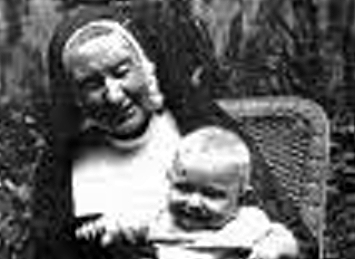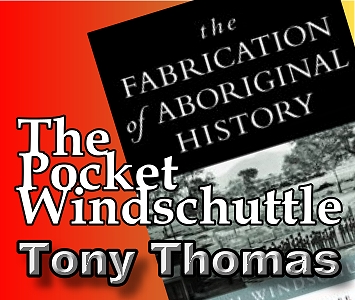The Pocket Windschuttle: Sister Kate of Perth – sinister racist
Tony Thomas: A saying from the early days of the Soviets was ‘When the forest is cut the chips fly’. It corresponds to our own saying, ‘You can’t make an omelette without breaking eggs.’ In the Soviet context, it referred to people destroyed for doctrinal reasons.
In our ‘Stolen Generations’ controversy, the historians have come across many individuals – including Aborigines like tenor Harold Blair – who devoted much of their lives to caring for, as they saw it, child Aborigines and half-castes and children of half-castes. Since the historians want to make the case that these people operated within a genocidal-type agenda, these people are required to be viewed as racist villains.
In Perth, Sister Kate Clutterbuck is one such villain.
[Note: All page references are to The Fabrication of Aboriginal History – Volume Three: The Stolen Generations 1881-2008 by Keith Windschuttle (Macleay, 2009)]
Keith Windschuttle describes the ‘stolen generations’ historians’ defaming of charity workers and religious figures who spent much of their lives selflessly caring for Aborigines:
Free from any risk of defamation suits from their now dead subjects, and speaking from the comfort of tenured university positions with six-figure salaries, academics such as Peter Read, Anna Haebich and Raimond Gaita have written of ‘the criminals who enacted the programs’ and applied labels such as ‘sinister’, ‘hated’, ‘monstrous’ and ‘psychopathic’ to people like Emmeline Rutter, Ella Hiscocks, Sister Kate Clutterbuck, Sister Eileen Heath, Amelia Shackleton and Father Percy Smith who spent much of their adult lives under the same roofs and conditions as the orphaned, abandoned and unloved children they worked to save. p35
The Human Rights Commission (authors of Bringing Them Home) declined to call any similar living persons (e.g. officials and welfare workers) as witnesses; they never gave the ‘captors’ of the children the chance to answer these damning charges. It only wanted to hear from those claiming to be ‘stolen children’. p36
So let Windschuttle now defend Sister Kate, an Anglican nun.
Sister Kate first ran a boarding school for needy children, mainly white, at Parkerville, Perth. It had been set up in 1902 for orphaned and unwanted white babies (e.g. illegitimate ones) and evolved into caring for older children, including a few Aborigines. At that time there were no pensions for single mothers. p317
Sister Kate in 1934 then established a home at Queens Park in Perth explicitly for quarter-caste children in need of care. Bringing Them Home identified Sister Kate’s’ as a place established to house Stolen Generations. p318 It was government-subsidised and initially housed about 20 children. p408 (A later chairman of Sister Kate’s was none other than Sir Ronald Wilson, chair of the Human Rights Commission and its Bringing Them Home Report. p267).
Historian Anna Haebich wrote:
Nevertheless his (WA Chief Protector A.O. Neville’s) determination to ‘make black go white’ remained practice at Sister Kate’s into the late 1940s, and it left a painful legacy for the children who inadvertently became part of this experiment in social and biological engineering…
The humanitarian rhetoric espoused by authorities at the Home masked these sinister aims and the associated violence to the children and their families, and all became inextricably linked in the fervent claim that this was ‘for the children’s own good’. p425
Poor Sister Kate. She worked 40 years in WA housing, feeding, clothing and educating orphans, abandoned babies, destitute and disabled children – only a minority of whom were Aboriginal. She created, instead of impersonal institutions, a new model of cottage homes where staff sought to give individual love and attention to each child.
In her youth she took a vow of poverty and thereafter lived and worked in the same premises as the children. In WA, with few funds from church or state, she labored to raise funds herself through fetes, concerts and (probably) cake stalls.
Windschuttle writes:
Over this time she created three separate establishments for her charges. In the course of her life, she also suffered the indignity of church politics that insensitively and prematurely ousted her from her position. Anna Haebich has defamed a good woman. p425
Kate was born in 1861 in England. At 22 she joined the C of E Sisterhood in London, and trained in nursing and dispensary before becoming a nun with Sister of St Michael’s Convent, Kilburn. For 15 years she did welfare work in the slums and dockside of London and in the orphanage at Kilburn.
In 1901 she and four other nuns sailed for Perth with 22 child migrants from Kilburn orphanage. By end 1903, they had found the money for and built the Parkerville home for babies and orphans in the Darling Ranges near Perth, initially known as ‘The League of Charity Home for Waifs and Stray Babies’. It soon included a government-funded public school.
In this era when state welfare was rudimentary, she spent decades schmoozing the rich for donations and massaging The West Australian for a ‘Million Pennies’ donation drive among readers. p426
Her ‘clients’ included (virtually all white) orphans, illegitimate children of poor or alcoholic single parents, disabled and mentally retarded children, children exposed to domestic violence, and children of prostitutes found living in brothels. But by 1932 she had 28 Aboriginals aged three to 19, out of a total of 143 charges. There were also children of Afghans, Japanese, Maoris, Chinese etc. Neither Kate nor the children, it appears, gave a stuff about anyone’s race.
By 1932, at the age of 71, she fell foul of Perth’s Anglican Archbishop Henry Le Fanu, who wanted to kick her out and replace her with young nuns from his former Brisbane diocese. Unwilling to retire, she got advice from Paul Hasluck (later our Governor-General, then a sub-editor on The West whose roles included correcting the spelling and grammar of my father Pete Thomas, a first-year cadet).
Hasluck drew her attention to plight of light-skinned part-Aboriginal children who were classed as neither black nor white for welfare purposes and hence missed out on care. She was enthused and offered to run such a home on behalf of Protector A.O. Neville but without cash from him. Being cash-strapped, Neville was overjoyed at her offer of something for nothing. He would choose the kids and remain their legal guardian.
Sister Kate made her sole criterion for selection equally clear:
We should of course like to have the most poorest and neglected children, not those who have mothers who love and care for them, but those who are most unwanted in the State. But we must leave that to you.p427-428
What a horrible hypocritical sinister person was Sister Kate! Well may she be damned by historian Anna Haebich, who quoted that italicized statement but dismissed it as part of the public ‘fiction’ maintained about Kate’s motives over the years.
Yet Kate was writing a private letter to Neville. She had no reason to use any deception or façade. The only people with cause to doubt her honesty are those pre-determined to paint her in terms as unfavorable as possible, Windschuttle says. p428
Via this deal, Neville got authority over both Kate’s small seaside cottage near Cottesloe, for pre-school infants, and a five-acre site at Queen’s Park on which was built, with a state lotteries grant, a six-bedroom cottage home for the new lot of Aboriginal children. They were all of school age and schooled at a nearby state school. The two homes were then combined. Queen’s Park, known informally as the ‘quarter-caste home’ then housed 22 children, all originally from the Parkerville babies home. She agreed to take another six ‘quarter-castes’ from Neville’s Moore River Settlement. p429
Historian Haebich somehow conflates this into the onset of large-scale racial engineering by Neville of Aboriginals into whites. Haebich claimed, correctly, that some of Neville’s teenaged Aboriginal women sent to domestic service, got pregnant to whites, and Neville removed their children from them. This was bad but the same thing routinely happened to white teenaged mothers as well – their child was removed.
Haebich was wrong however in claiming that such of Neville’s baby wards went to Sister Kate’s. In Neville’s statement to a 1937 conference, he never mentioned Sister Kate’s in that context at all. But Haebich injected the link to make the story fit with her line about them being placed in Sister Kate’s so they would grow up as whites and ignorant of their Aboriginality. p430
Haebich refers to ‘scores of practically white children’ that Neville removed into Sister Kate’s hands, an even greater beat-up, Windschuttle says. Over ten years, Sister Kate’s’ home took in an average 15 children a year. Not much hope of ‘biological engineering’ there to end the Aboriginal race.
Haebich’s determination to destroy the reputation of this English nun is obsessive, Windschuttle says, quoting Haebich below:
“Selected according to criteria of corporeal whiteness, (the children) were submitted to techniques of social engineering to make their minds white as well…Contact with Aboriginal family members was strictly curtailed. Children were told they were orphans or abandoned by uncaring parents and some grew up not even knowing they were of Aboriginal descent.” p430
Testimony from the children themselves varies. Haebich selected testimonies that were critical of Sister Kate’s style. Windschuttle, by contrast, quotes a boy’s favorable testimony and says Haebich should have provided a balanced selection. The boy says:
I was a proper orphan … Sister Kate was a wonderful person. She was such an anchor, especially to a kid like me. There were some like me, but some had brothers and sisters and later on they were able to find their mothers and fathers. I was lucky because my aunties and uncles used to come down see (to Sister Kate’s). That was one good thing. p431
Paul Hasluck was a patron of Sister Kate’s’ for many years, continuing to describe it, as Neville did, as a safe haven for kids who couldn’t access care designed for either whites nor blacks.
Windschuttle concludes:
“There is no good reason for Haebich to prefer a vast racist conspiracy to the perfectly plausible explanations of those who took the principal decisions at the time.” p432
I wonder how it would go if Sister Kate tomorrow climbed out of her grave and sat academic historian Anna Haebich down for a little chat. I’d love to be a fly on the wall. I bet the chips would fly.
Buy The Fabrication of Aboriginal History – Volume Three: The Stolen Generations 1881-2008 here…
 Sign In
Sign In 0 Items (
0 Items ( Search
Search








